
The Government of India has notified the outbreak of African Swine Fever (ASF) in Assam. ( See notification ).The Government of Assam has constituted a core group of experts on 2nd May 2020 to aid and advise the Government of Assam in making decisions on containment measures and other precautions to be adopted. On 6th May 2020, the Government of India has set up a control room at the Department of Animal Husbandry and Dairying to strategize, coordinate and facilitate state governments with regard to the outbreak management, disease control, and containment as envisage in the Prevention and Control of Infectious and Contagious Diseases in Animals Act 2009. ( Download Order ). During June 2020, Government of India released the National Action Plan for control, containment, and eradication of African Swine Fever ( Click Here to download )
Following is our suggestion to the core group and Government of Assam in continuation of our earlier suggestion to the Government dated 11th May, 3rd May and 29th April, 2020 ( Please refer towards the end of this page )
Rebuilding the Piggery sector in Assam: Suggestions to the Government of Assam dated 17th June 2020
Action Points:
- Invest in commissioning of a GIS / Remote sensing-based decision support/trade facilitation system for the management of ongoing and the future outbreak of diseases. ( Clear and dynamic demarcation of various zones along with the implementation of measures like checkpoint-for adherence to demarcation related notifications is the first step )
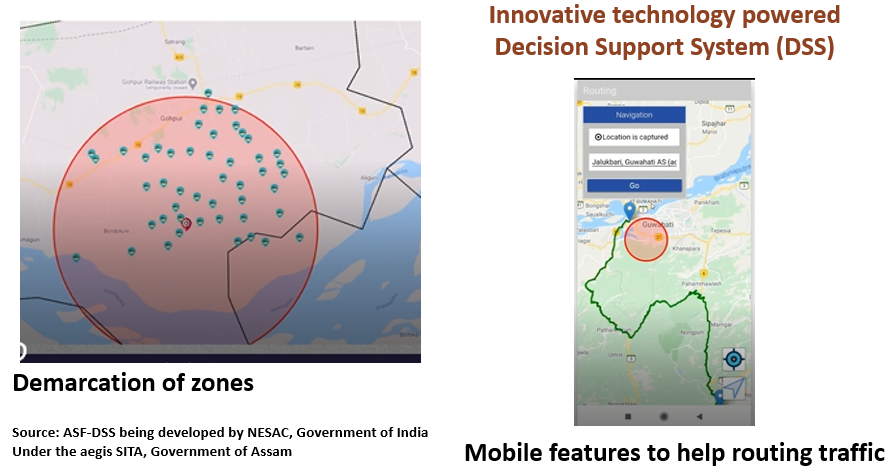
- Pro-actively engage with farmer association/cooperatives/producers companies to improve their capacity to enforce government-supported premises registration of members, and use of an application-based disease reporting, the bio-security scoring system for their member farms.
- Improve investment in disease detection, epidemiological investigation and, continuous risk mapping.
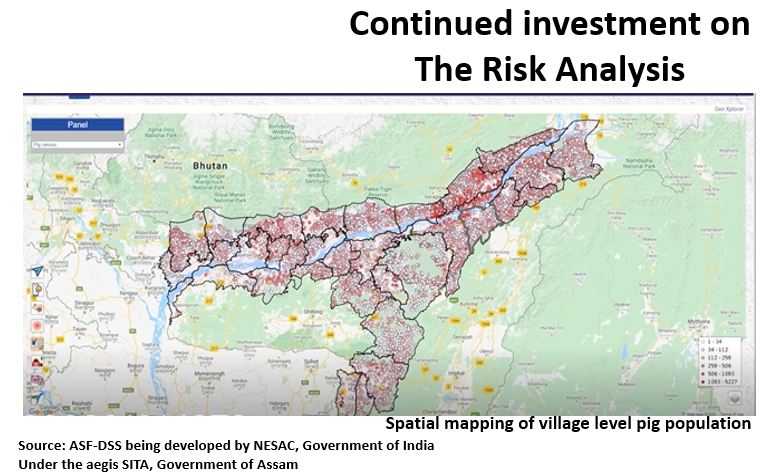
- Invest in laboratory capacity ( e.g., infrastructure, consumables, and workforce ) and field awareness /enforcement of disease control related protocol.
- Promote multi-stakeholder engagement, e.g., joint action with the forest department
- Provide resources to a specially notified team of researchers to work on documentation of field efforts of Veterinary Services/Forest department, research on the role of vectors, planned introduction /monitoring of sentinel pigs, and all the other reports necessary for permission to farms/farmer organizations for safe and early restocking of pigs.
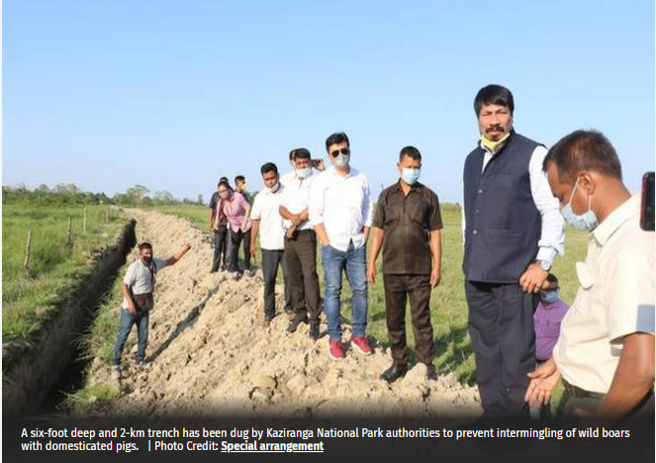
Sri Atul Bora, Honorable Minister Agriculture, Horticulture and Food Processing, Animal Husbandry and Veterinary, Government of Assam inspecting work at Kaziranga National Park for preventing contact between wild boar and domesticated pig. Source: The Hindu
- Document and compensate for the loss of farmers. Promote insurance and strengthen banker’s confidence in the sector for enhanced credit delivery.
- Support industry-led generic advertisement and pork certification campaign to promote locally produced pork and to help generate the consumer and investors’ confidence.
- Strengthen disease communication and prevention campaigns.
- Revisit the sector-level development strategy focusing on achieving competitiveness and help unite small farmers as cooperative / producer companies.
Download: The Pig sector action plan suggested under Assam Vet Roadmap Project
Download: Action areas for animal disease control and regulatory services as suggested under Assam Vet Roadmap Project
Click Here for OIE Communication resources for African Swine Fever
Click Here for FAO manual for African Swine Fever Detection and Diagnosis ( For veterinarians )
Policy imperatives:
- The incentive for disease reporting and adoption of good husbandry practices
- Mechanism of partnership with the private sector for disease control
- Outsourcing private personnel for any public function
- Regulation on disease control ( Improvement of rules related to Prevention and Control of Infectious and Contagious Diseases in Animals Act 2009 )
- Creation of an Emergency Fund for disease control and business continuity support
- Incentive to promote private investment in organized operations
The suggestion to the core group as on 11th May 2020
Topic: Handling of pig disease outbreak in Assam – Deciding on stamping out strategy and other suggestions
The following excerpts of the FAO manual on “Procedures for disease eradication by stamping out’ highlights the factors for evaluation before deciding on stamping out as a strategy for control of any animal disease.
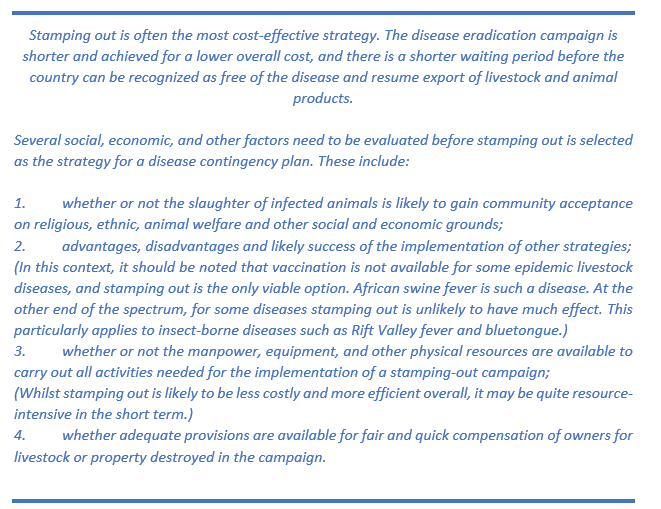
The following situation in Assam as on 10th May 2020, is forcing us to ponder whether ‘stamping out’ as a strategy will be successful:
- The resource constraint has led to sufficient delay in completing the mandatory detailed outbreak investigation, identification of zones, and formal notification of the disease as African Swine Fever. The report regarding the outbreak has started to emerge since the later part of February 2020 itself. The state received laboratory confirmation of ASF on tested samples on 3rd May 2020.
- There is observed difficulty in achieving coordination amongst institutions, e.g., notification of local laboratories for ASF testing. There is also limited control over the practice of throwing the carcass of pigs to rivers.
- Community acceptance and cooperation for stamping out appear to be difficult, primarily in the context of smallholder farmers and those rearing free-ranging animals. Regular animal deaths due to diseases like CSF are common. So, there is limited risk perception.
- Majority Commercial pig farms do not have insurance coverage and are growing with bank liabilities. In a situation where a commercial farm is not infected, the owner entrepreneur is likely to resist culling even if there are confirmed cases in backyard farms or the location of the commercial farm is near to the infected zone—the organization of commercial pig farmers viz. North East Progressive Pig Farmers Association has already submitted a memorandum to the Government objecting to any blanket culling of pigs. ( Download memo of NEPPFA )
- For many ethnic communities, the impact of the general stamping-out approach will go far beyond financial loss.
- The financial situation of the state due to COVID_19 is already grim. If market-level compensation is not paid to owners of animals compulsorily slaughtered, illegal movements may occur, and the disease can spread faster and last longer as a result.
- There is inadequate data on pig farms/population; this will make compensation planning and delivery complicated.
- There are limited capacity / internal resources within the Department of Animal Husbandry and Veterinary to implement stamping out as a strategy within the required timeline. Ongoing restrictions due to the surge of confirmed COVID_19 cases will make implementation more difficult.
- There are already unconfirmed reports of farmers forcing veterinarians not to report the death of pigs from their locality fearing culling.
- The general election in Assam is forthcoming, and the adoption of ‘stamping out’ as a strategy with limited success in disease control within a shorter period will not be appropriate for the current political dispensation.
If not stamping out: What is the alternative?
If not stamping out, we need to accept the fact that ASF disease-free status is a distant reality for Assam as a state. We, in that case, should aim for strict enforcement of bio-security, mitigation of loss, and support for organized farm growth and trade within the free zone(s) beyond the properly demarcated long term containment zone (s).
We need to focus on mobilizing resources for the following:
- To improve the needed authority and capacity of laboratories for testing of samples within the state.
- Continued investment for engagement with district and up to panchayat/village level civil administrations for implementation of bio-security, movement control, and scientific disposal of the carcass.
- The more focused initiative to disseminate information on bio-security and appropriate cleaning /disinfection related procedures. The facility at the district level under the project North Eastern District resources Plan (NEDRP) can be utilized to identify risky villages on the bank of the rivers and to organize targeted awareness drive to prevent throwing of the carcass to rivers. ( Download Resource on Bio-security and Cleaning & Disinfection )
- Strengthening and strategic positioning of outbreak / epidemiological investigation teams for rapid response to citizen reports and sample collection following planned methodology. The state may decide to outsource private veterinarians.
- To get access to data from existing organizations already implementing farm traceability applications and to further invest in mandatory GIS-based farm premises registration. ( Starting with farm/premises visited by teams for sample collection )
- To build the internal capacity to improve disease surveillance ( ( Both Active surveillance of reported cases and early sign surveillance or syndromic surveillance ) and to prepare a real-time map of disease data.
- To analyze data for exploring the possibility of implementing only a risk-based ‘Stamping out’ strategy, focusing more on forest fringe villages. (stopping the disease from getting established in wild boars )
- To achieve the data transparency to scientifically define the boundary of a long term containment zone(s).
- To conduct a socio-economic risk assessment and market chain analysis to advise notification of a detailed long term trade and movement restriction between free and the containment zone(s).
- To build the capacity of any public/private agency or farmer association to develop a sustainable scientific risk-based scoring system to evaluate the quality of biosecurity.
- To invest in rehabilitation, investment promotion, organization of farmer collectives, and the creation of required infrastructures in each zone to ensure farm input delivery and the immediate market for pork following the recovery of the situation.
……………………………………………………………………………………………………………………………
The suggestions to the core group as on 3rd May 2020:
- Discuss on terms of reference, resources available to the core group, and ways and means to seek further expert suggestions from people and organizations across the pork value chain.
- Discuss ways to improve communication to make the public appreciate and understand the disease control methods. The group preferably should assign a member the responsibility of acting as a single point spokesperson. The core group should preferably approve all official communication before release.
- Engage with any University with Department of Mass Communication to provide help related to (a) Regular analysis of news in mass / social media vis a vis its possible impact on control measures (b) Drafting/review of specific communications (c) Guide on targeted campaigns. (d) Generation and publication of positive media content.
- Discuss on the opening of a separate cell within the Animal Husbandry Department’s existing call center & social media cell (with a required SOP) to record citizen reporting.
- Engage with appropriate authority for clarity on available funding (and ways to minimize procedural hassles related to timely release). Discuss the scope and ways to ensure interdepartmental collaboration, e.g., With the forest department, with a state-level GIS facility.
- Assign a member of the core group to oversee the appropriate and quality documentation for outbreak response implementation.
- Initiate action to gather all available statistical data, Viz.., the record of the recent digital census, cluster level data available with the world bank funded APART project, Data from SLBC ( State Level Banker’s Committee ) on farms growing with bank finances, etc.
- Discuss core control activities, tracing, and a risk-based surveillance plan and required support thereof besides ways to monitor progress. Assigned appropriate person(s) the custody of all reported data. Empower such persons to check quality issues related to reporting.
- Explore the feasibility of the establishment of the containment zone(s) with a targeted timeline. (Information that justifies the proposed boundaries of the containment zone is critical). Seek an opinion from APEDA (The Agricultural and Processed Food Products Export Development Authority) to understand the benefit of having a containment zone(s) from an economic / export point of view. A containment zone will help India maintain its free status outside the zone and resume trade accordingly. A containment zone is possible even cases are occurring within the infected zone, provided there is no outbreak in the protected zone for at least two incubation periods. ( Refer chapter 4.3 of the OIE Terrestrial Animal Health Code -where needed )
- Decide on a war footing the objective of the control program, and suggest government for the deployment of the field team with assigned responsibility and access to resources.
……………………………………………………………………………………………………………..
Suggestions dated 29th April 2020:
There are recent reports of largescale death of pigs in Assam. The confirmatory diagnosis is expected from the Government very soon. Following is our suggested immediate action points to the Government of Assam to control the disease outbreak:
Suggestions:
Please form a core group of experts at Animal Husbandry and Veterinary Department with earmarked financial resources at the disposal of the group, ensuring participation of
-
- Epidemiologists
- Infectious animal disease expert
- Expert in finance with exposure in compensation planning,
- Expert in communication/extension,
- Expert in sectoral policy formulation
- A representative of the farmer’s association
- Persons associated with Pig/ pork processing and trade of pork products.
- A representative of the forest department
The core group should evaluate the established guidelines, ground situation, livelihood impact, impact on commercial/nucleus breeding farms, institutional capacity, fund provision for compensation and future trade prospect of the sector, etc. and guide the specific control measures accordingly.
- Notify a comprehensive bio-security / movement control/ prevention of garbage feeding-related rules under the suitable provision of Prevention and Control of Infectious and Contagious disease in Animals Act,2009, and give wide publicity of the same in the local language.
- Ensure availability and access to farm disinfectants amongst pig farmers across the state.
- Orient field persons of the Department of Animal Husbandry and Veterinary to take all possible care to ensure biosecurity during necessary travel between pig farms. Temporarily suspend all farm/community level vaccination of pigs in affected districts by animal health personnel.
- Prevent the virus from becoming established in wild pig populations. Improve surveillance and management of dead carcass of wild boar etc. (if any) within the forest/fringe area. Ensure awareness and active monitoring in forest fringe villages.
- Form multiple outbreak investigation team—record maximum possible cases. Urgently investigate the reports of river water contamination /floating dead pigs and ensure prevention at a potential source point and immediate scientific disposal of such carcasses.
- Involve the College of Veterinary Science to undertake a priority investigation of risk factors, including the role of vectors ( e.g., ticks ), if any, in the transmission of the disease in the pig.
- Discuss with stakeholders within the state having an existing IT-based pig traceability program. Fund development of a mobile application on war footing so that farmers can send GPS locations of their farms with detail of stocks besides real-time reporting of cases. The application data will be useful to map growth areas vs. areas with an outbreak and to undertake focused bio-security measures/movement control.
- Immediately ensure direct transfer of suitable incentive to a minimum of 100 volunteer leader farmers ( PHWs-Pig health warriors! ) per affected district with a task to create awareness within the stakeholders and help the Department of Animal Husbandry and Veterinary in the robust implementation of bio-security and movement control.
- Immediately depute an empowered team of veterinarians and police personnel to trade-related entry and exit points to implement inter-state trade restrictions.
(Prepared by Assam Vet Roadmap project team of Vet Helpline India Pvt Ltd in consultation with key farming and processing sector stakeholders including The North East Progressive Pig Farmers’ Association (NEPPFA) )
 The purpose of this publication is to promote informed debate and collective decision making for the greater interest of the piggery sector in Assam and North East India. We are also using social media to reach out to policy initiators, experts, and progressive farmers/entrepreneurs. Vet Helpline India Pvt Ltd does not claim a hundred percent accuracy or completeness of the content on this page.
The purpose of this publication is to promote informed debate and collective decision making for the greater interest of the piggery sector in Assam and North East India. We are also using social media to reach out to policy initiators, experts, and progressive farmers/entrepreneurs. Vet Helpline India Pvt Ltd does not claim a hundred percent accuracy or completeness of the content on this page.
More more resources:
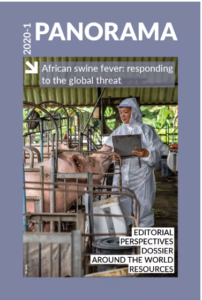 OIE Bulletin- Panorama 2020-1: African swine fever: responding to the global threat Click Here
OIE Bulletin- Panorama 2020-1: African swine fever: responding to the global threat Click Here
Event Alert:

African swine fever: An unprecedented global threat – A challenge to livelihoods, food security, and biodiversity. Call for action
Click Here to register
Please post your comment and suggestions here. We intend to collate all suggestions for onward submission to the appropriate authority within the Department of Animal Husbandry and Veterinary, Government of Assam.




